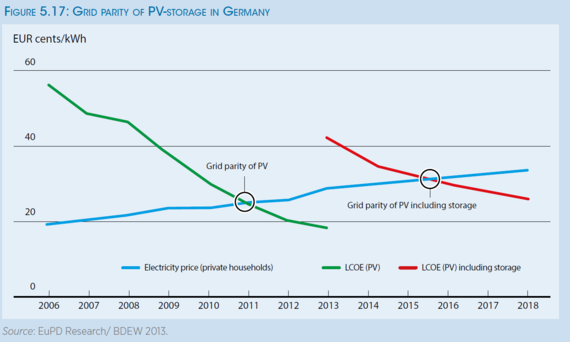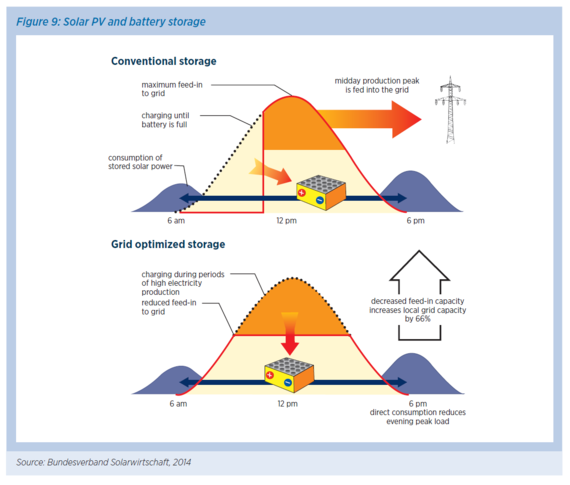n a study published this month, IRENA provides a global scope, though the depiction of Germany indicates that the wide range of countries covered may have come at the cost of some depth.
In January, the International Renewable Energy Agency (IRENA) published five studies, each of which looks interesting. I recently presented the country report on the US. Today, I would like to briefly review a second one entitled “Battery storage for renewables: market status and technology outlook.”
First, the organization’s international scope means that the study covers a wide range of cases globally, with a particular focus on islands. As small grids, islands represent a special case because power trading – which can reduce the need for storage – is greatly reduced or non-existent. But small grids in the developing world are also a main area of applications.
There, cost considerations are much different than in the developing world; instead of comparing the cost of renewable power + storage to the grid, the comparison is with offset fuel costs. In other words, the story differs considerably depending on the market, but in general battery storage is the most competitive option on islands and in remote areas.
To my surprise, Japan has the greatest battery storage of all countries investigated, though the US clearly has the most in the pipeline. Despite all the focus on the alleged need for storage in Germany, the Germans actually turn out to have very little built and not much more in the pipeline.
There is a caveat to this finding, however; as with the Pew study on clean energy investments, data for small systems are hard to come by. As the study puts it: “The data presented in figure 22 underestimate battery storage because they do not include decentralized installations, such as at households or commercial facilities. The small size and private nature of these installations often do not show up in datasets.”
One of the most interesting presentations in the study is the following table showing what battery storage costs, in this case in Germany. The price at the bottom of each column indicates that we are easily looking at 40 cents per kilowatt-hour – and that does not include the cost of the electricity to be stored. At present, it seems that stored solar power, for instance, would easily cost 50 cents per kilowatt-hour, which brings us all the way back to the relatively high price of solar power without storage a decade ago.
The country report for the US also included an interesting chart I would like to bring into the discussion now.
Here, we see that there are two types of grid parity. The first point is where the cost of solar power equals the retail rate; the second, where the cost of solar power plus storage equals the retail rate. A few years ago, people generally held the first point of overlapping (without storage) to be the Holy Grail (I did not). The second point is far more important because it represents the point where grid defection can begin to take place – households will find it cheaper to generate and store their own electricity from solar panels than to buy from the grid. And the fascinating thing is that IRENA expects this point to be reached this year based on German data.
This finding flies in the face of the current small market size. The chart assumes “a 5 kWh battery pack and a starting point of EUR 2 300/kWh in 2013 for li-ion battery packs.” It also does not assume that Germans will be able to go completely off grid affordably this year with PV + storage:
“Although it will not make sense for consumers to become totally self-sufficient, they will have an incentive to increase the level of self-consumption and market growth could potentially decouple from financial support levels and become self-sustaining.”
The challenge in Germany for PV + storage will be seasonal – getting the modest amount of sunshine from the summer into the winter, when electricity and energy consumption both rise steeply. IRENA is thus merely saying that the point where German households can affordably begin making and storing more of their own solar energy instead of buying from the grid is practically here. The challenge of closing the winter gapremains, however.
Interestingly, IRENA uses some slightly out of date information for Germany. For instance, the study writes:
“A proposal now under consideration to tax electricity self-consumption would alter this formula, negatively affecting the economics of storage with solar PV power.”
In fact, that proposal has been law since August, and PV arrays smaller than 10 kilowatts (meaning more or less all households) are exempt. Furthermore, the cost estimates for feed-in tariffs are a bit outdated:
“in Germany, new systems installed at the end of 2014 will receive an approximate FiT value of between EUR 0.12 and EUR 0.15/kWh, depending on their size (Bundesnetzagentur, 2014), while retail tariffs are around EUR 0.30/kWh.”
Current rates are available here (in German). But on 1 December 2014, for instance, the highest rate paid was 12.99 cents per kilowatt-hour; the lowest, 9.12.
Ironically, because the prices are actually lower than IRENA indicates, the point of grid parity for PV + storage is actually closer than the study indicates. But elsewhere, the researchers show they were collecting the latest data up to the deadline for publication, such as when they state that “around 12% of solar PV systems were installed with a battery system” in Germany, statistics that were only published in the fall.
Finally, the study goes into the question of whether residential solar power storage systems should be tailored to reducing a household’s dependence on the grid or addressing what the grid needs, as the chart below shows. I recently called for a greater focus on grid-focused optimization with a similar chart here.
I have only covered the aspects pertaining to Germany because that’s what I know best, but the study is thus definitely worth reading for its much broader scope. For instance, four years ago I wrote about how China was building wind turbines faster than they could be connected to the grid, with roughly 30 percent of installed capacity not actually generating electricity. Who knew that, even today, only 61 of China’s 75 GW of installed wind capacity is actually working.
(This news story is from ReNew Economy)













